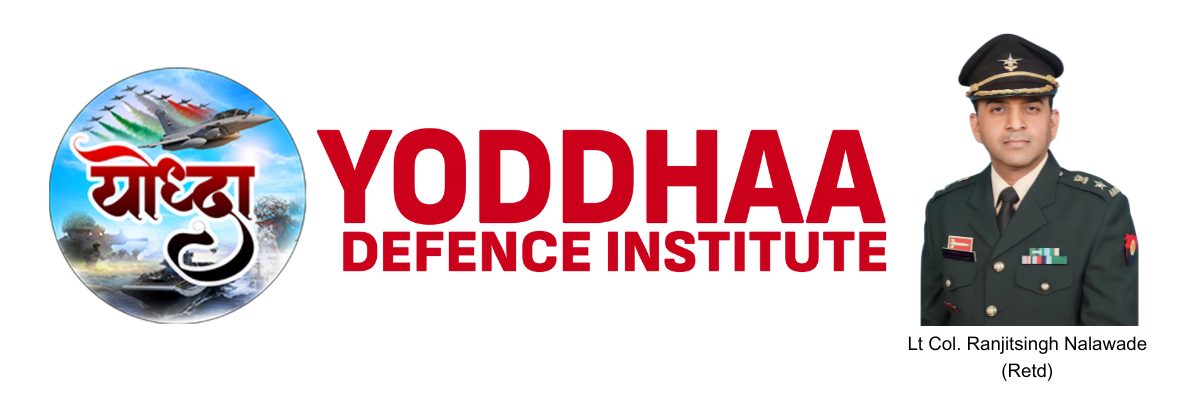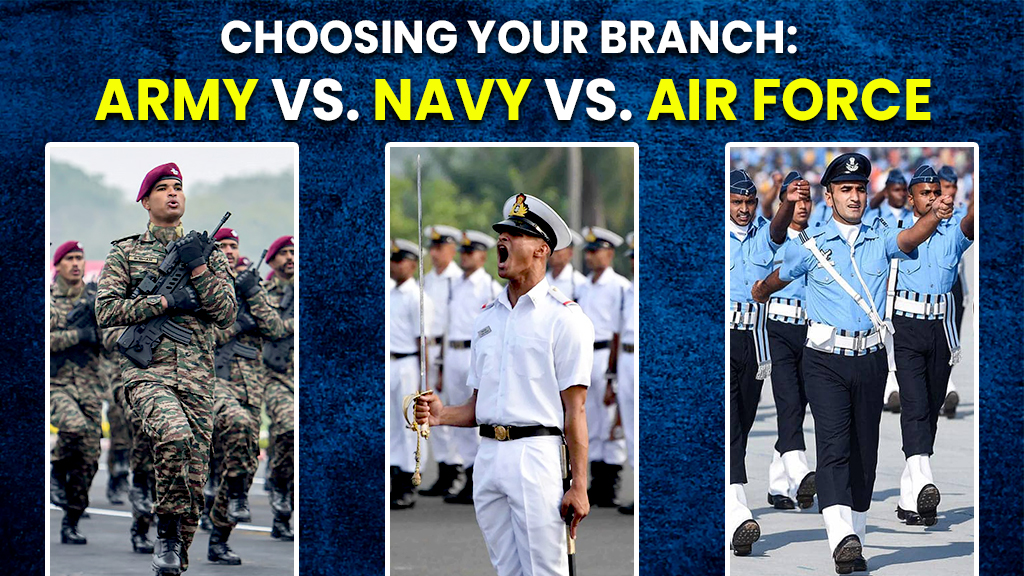At dawn in the faint glow of light, a proud youth cadet on the academy’s parade ground feels his heart sorrow with desire for service to the nation. Above them, flags for the three branches of services swirl in the early morning breeze, a living indication of common roots and individual tradition of Army, Navy, and Air Force.
To choose between land, sea, and air is to answer a deeply personal call: to command troops over rugged mountains and plains, to defend the naval perimeter and sustain India’s blue-water ambitions, or to dominate the air and defend the country’s skies.
Each branch has its own distinct mission of warfare and single tradition of service, from Army officers standing guard at frontiers and securing internal stability, to Navy commodores projecting naval power across oceans of thousands of miles of seacoast, to Air Force pilots and officers of ground duties flying advanced aircraft from high-level corridors to compassionate missions on hard surfaces.
Against this background, each candidate must balance individual strengths, physical stamina, technical skill, and leadership aspiration against the demanding standards and illustrious heritage of each service. Their decision will determine the path of a career characterized by courage, sacrifice, and an abiding devotion to the Republic of India.
Decision among the Indian Army, Navy, and Air Force is one of the largest defence-aspirants ever have to make. Apart from the colour of the uniform, each of these units provides varying training regimens, functional positions, career options, and lifestyles.
The decision determines the career path but also individual growth, home life, and future destinies whether in tactical control, technical competence, or planning.
Eligibility & Entry Pathways
NDA vs. CDS vs. AFCAT vs. Naval Academy Entry
- NDA (10+2 Entry): Twice a year by UPSC, for unmarried men and women in the age group of 16 to 19 years. Army wing allows any stream, Navy and Air Force need Physics, Chemistry & Mathematics.
- CDS (Graduate Entry): For graduates 19 to 24 years, selected for IMA, INA, AFA, and OTA (SSC).
- AFCAT (Air Force Common Admission Test): Graduate entry for flying, ground duty technical, and non-technical branches; includes CPSS for pilot aspirants.
- Naval Academy (10+2 Cadet Entry): Separate UPSC NDA exam scheme for INA Ezhimala with PCM requirement and CPSS for Pilot/Navigator entries.
Medical & Physical Standards
- Army: 6/6 vision (uncorrected/correctable), specific height/weight ratios, chest expansion minimum 5 cm.
- Navy/Air Force Flying: Uncorrected 6/6 vision with no myopia (nearsightedness), stringent cardiopulmonary and vestibular criteria.
- Ground Duty (AF & Navy): More lenient vision (6/36 correctable) but still stricter than Army.
Training Academies & Curriculum
Indian Military Academy (IMA), Dehradun
- Duration: 3 years at NDA (all branches) + 1 year at IMA for Army cadets.
- Curriculum: Leadership, tactics, weapons training, military history, field exercises, and adventure sports.
Indian Naval Academy (INA), Ezhimala
- Duration: 3 years NDA + 1 year naval specialization; additional training for executive, engineering, and pilot branches.
- Curriculum: Seamanship, navigation, marine engineering, warfare systems, sea training cruises.
Air Force Academy (AFA), Dundigal
- Flying Branch: 3 years NDA + advanced flying training (Stage I & II) post-selection, including jet conversion.
- Ground Duty: Technical: avionics, mechanical; Non-Technical: administration, meteorology, rigorous academics and practical labs.
Roles & Operational Environment
Army: Land Warfare & Joint Operations
- Combat Arms: Infantry, Armor, Artillery: frontline leadership and direct action roles.
- Support Arms: Engineers, Signals, Army Aviation: specialized technical functions.
- Deployment Examples: High-altitude posts in Siachen, UN peacekeeping in Congo.
Navy: Maritime Security & Blue-Water Operations
- Fleet Units: Destroyers, frigates, submarines, sea patrols, fleet defense, deterrence missions.
- Ashore Roles: Naval aviation, logistics, hydrography.
- Deployment Examples: Anti-piracy patrols off Gulf of Aden, joint exercises with foreign navies.
Air Force: Air Superiority & Strategic Reach
- Flying Roles: Fighter, transport, helicopter, UAV operations with high-technology platforms like Su-30, Rafale, C-17.
- Ground Duty: Radar, air traffic control, cybersecurity, meteorology.
- Deployment Examples: Airlift in humanitarian crises, joint drills like “Garuda” with France.
Career Progression & Promotions
- Army: Commission as Lt., typical promotion to Captain in 2 yrs, Major in 6–7 yrs, command of platoon → company → battalion, senior leadership roles (CO, Brigade Major).
- Navy: Sub Lt. → Lt. → Lt. Cmdr. → Cmdr., opportunity for ship/boat command, staff appointments, and flag rank in maritime strategy planners.
- Air Force: Flying Officer → Flight Lt. → Sqn Ldr., roles include squadron leadership, staff at Air HQ, and aerospace command planning.
Lifestyle, Deployments & Family Considerations
- Army: Frequent field postings, tough terrain, rigorous PT, unit cohesion but extended separations.
- Navy: 2–3 month sea tenures balanced by long port stays, exposure to multinational ship life, then family-friendly shore postings.
- Air Force: Stable air-base rotations (2–3 years) with good infrastructure (schools, hospitals); occasional deployments for exercises.
Specialized Skill Requirements & Aptitude Tests
- Army GTO Tasks: Snake race, group planning: physical endurance and leadership under stress.
- CPSS (Air Force & Navy Flying): Multi-task coordination, instrument interpretation – key for pilot selection.
- Psychological Batteries: WAT, TAT, SRT – evaluate decision-making and personality fit across all services.
Real-World Case Studies
1. Army: Captain Vikram Batra’s Valor in the Kargil War
Captain Vikram Batra, of the 13 Jammu and Kashmir Rifles, was post-obituary awarded the Param Vir Chakra, the highest Indian military decoration for his extraordinary courage during the 1999 Kargil conflict.
On 7 July 1999, he led the daring recapture of Point 4875 under intense enemy fire, personally directing his men while exposing himself to sniper fire to evacuate a wounded soldier.
His citation highlights his indomitable spirit, famously signaling “Yeh Dil Maange More!” after his objectives were achieved and his ultimate sacrifice cemented his legacy as one of India’s most revered heroes.
2. Navy: Commissioning of INS Arihant and India’s Nuclear Triad
INS Arihant, India’s first indigenously built ballistic missile submarine (SSBN), was laid down in 2004, launched in July 2009, and after extensive sea trials was commissioned into service in August 2016.
This milestone completed India’s nuclear triad: land, air, and sea-based deterrence, providing the nation with credible second-strike capability and bolstering strategic maritime security.
The submarine’s pressurized-water reactor and ability to carry up to 12 K-15 Sagarika SLBMs mark a quantum leap in naval deterrence technology for a non-P5 nation.
3. Air Force: Squadron Leader Avani Chaturvedi’s Solo MiG-21 Sortie
Squadron Leader Avani Chaturvedi, born in 1993 in Madhya Pradesh, was among the first three women inducted into India’s fighter stream when the government opened it in October 2015.
In February 2018, she made history by completing a 30-minute solo sortie in a MiG-21 Bison at Jamnagar Air Base, becoming the first Indian woman to fly a fighter jet solo. Her achievement not only shattered gender barriers in combat aviation but also inspired a generation of women to pursue roles previously closed to them in the Indian Air Force.
Conclusion
Choosing your branch hinges on aligning personal strengths – physical resilience, technical acumen, leadership style with each service’s training demands, operational roles, and lifestyle trade-offs. Yoddhaa Defence Institute offers:
- Branch-Specific Workshops: Early CPSS simulations, GTO obstacle training, and ground-duty skill labs to clarify real-time preferences.
- Structured Mentorship: Sessions with ex-Army, Navy, and Air Force officers to clarify branch cultures and career pathways.
- Comprehensive Entry Prep: Integrated syllabus mapping for NDA/CDS/AFCAT including branch-wise medical coaching, current-affairs briefings, and timed mock-tests with error analytics.
- Comprehensive Support: Personality development, fitness regimens tailored to branch standards, and one-on-one counseling to finalize branch choice with confidence.
By leveraging Yoddhaa’s multi-pronged training ecosystem, aspirants can objectively assess their fit for the Army, Navy, or Air Force and embark on a career path that best matches their aspirations, aptitudes, and life goals.

